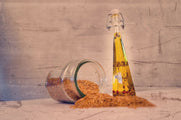Food Waste in Australia
According to the Food and Agriculture Organisation of the United Nations, each year about a third of the food produced globally, that’s intended for human consumption, goes to waste.
Certain categories of food (like root crops, fruit and vegetables) have even higher rates of loss and waste - some estimates put that number at 40-50%.
In total, about 1.3 billion tonnes of global food is wasted every year. Those are shocking statistics. Sadly, Australia is not immune with the average household throwing away around 3.1 million tonnes of household food waste each year and the commercial and industrial sector with 2.2 million tonnes of food each year.
This all adds up to an amount of food totalling over 5 million tonnes ending up in landfill. The federal government estimates that national food waste costs the Australian economy $20 billion each year.
Where Does the Waste Happen?
Every step along the way during food production, processing, distribution, and consumption contributes to waste - this is the supply chain flow.
Crops may lie untouched in the field if markets change and it’s no longer profitable to harvest. A week before harvest a hailstorm may wipe out fields full of tender plants. Misshapen or undersized produce may never make it to market. Mice get into storage bins. Moisture degrades stored grains until they are unusable.
The household flow rates estimate that Australians discard up to 20% of the food that is purchased...now that’s just a waste of edible food!

Production Challenges are Just the Start
Getting food off the farms is just the first challenge. Produce can be damaged in shipping. Once in the stores, lightly bruised or damaged products are spurned. If you’ve ever watched people at the market pick through fruit in search of perfectly shaped and unblemished specimens you’ll know what we mean. Often, the fruit and vegetables left behind are perfectly edible.
We All Have a Part to Play
At home, we have all been responsible for not quite making our way through all the leftovers or forgetting a head of lettuce in the back of the veggie drawer only to discover it weeks later after it has transformed into some that looks nothing like lettuce. This is the perfect opportunity to feed your worm farm or compost bin! The NSW government and others have supported initiatives of councils providing online resources, discounted compost bin, compost aerator, worm farms and worms through programs designed to encourage residents to recycle all that unavoidable waste.
Some commercial waste is inevitable (like fruit and vegetable peels, egg shells or inedible seeds) but consider how much food is sent back to restaurant kitchens for disposal because portion sizes have outstripped our appetites. Sharing a meal when you eat out is one easy way to minimise what gets tossed at the end of the evening.
Can We Afford to Squander Resources?
Not only does food go uneaten, resources (water and fuel), land, labour, and funding are squandered.
Small farmers suffer when income is lost and consumers wind up paying higher prices than is necessary. Burning unnecessary fuel and leaving tonnes of food to rot both contribute to higher greenhouse gas emissions.

Rawmate Leads the Way
We at Rawmate aren’t going to just sit around and shake our heads at this state of affairs. In order to produce Rawmate, our top notch gourmet dog food, we’ve partnered with some of Australia’s largest commercial kitchen and produce farmers. They provide us with a steady supply of vegetable offcuts and odd-looking produce that won’t be sold in supermarkets because they won’t pass visual inspection.
Good for Our Dogs, Good for the Planet
Including ingredients originally intended for human consumption accomplishes several things. First, our dogs love to eat real, whole food. It tastes great! We don’t overdo it, of course. All of our meals for dogs are carefully balanced with our canine friends’ nutritional needs in mind and comply with AAFCO standards. But when we can use whole foods that might otherwise be wasted, we are also helping tackle the problem of food waste.
Let’s Keep this Conversation Going
We’d love to see more people talking about this issue and finding clever, collaborative ways to improve the situation. We can all think about changing our habits and talking to our children about new ways to think responsibly about food. New strategies to minimise for waste can be taught at agricultural schools and in hotel and restaurant management courses.
We’re taking this crisis seriously enough that we’ve integrated more sustainable production practices into making every tasty meal you serve to your dog. We’re delighted to have found socially responsible partners in agriculture and food production to work with us as we tackle the challenge of reducing food waste at all stages in the food supply chain.
If you want to know more about AAFCO Nutritional Guidelines we wrote about it on our What is AAFCO and Why you should care blog







There are 0 Comments